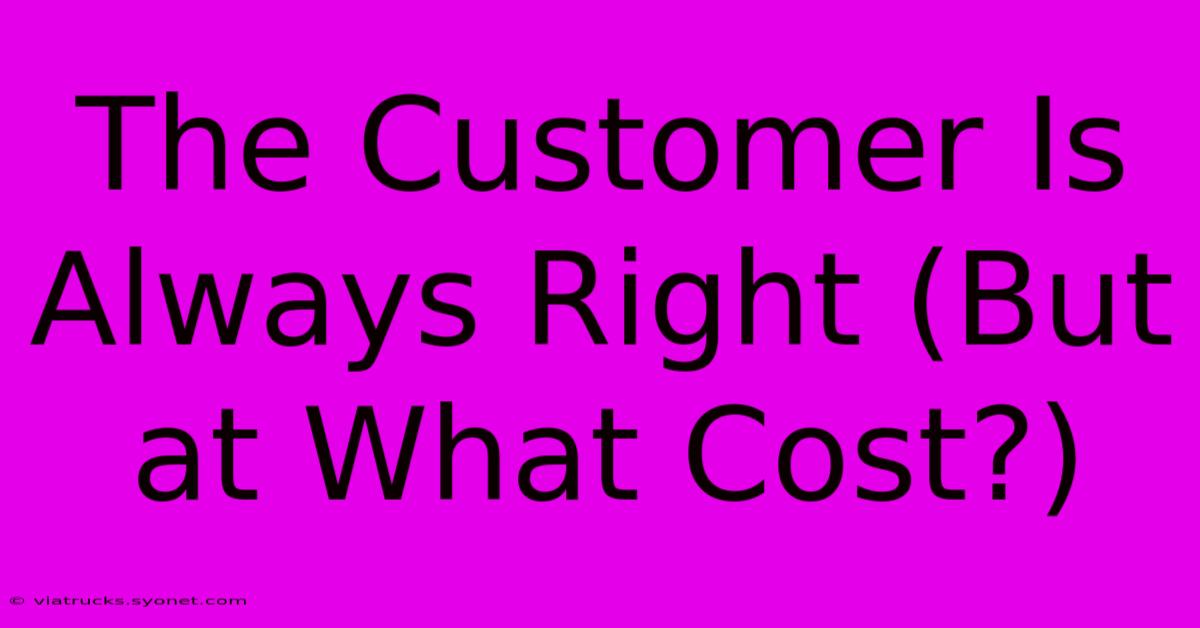The Customer Is Always Right (But At What Cost?)

Table of Contents
The Customer Is Always Right (But at What Cost?)
The adage "the customer is always right" has been a cornerstone of business philosophy for decades. But in today's complex commercial landscape, this unwavering principle is facing increasing scrutiny. While prioritizing customer satisfaction is crucial for success, blindly adhering to this maxim can be detrimental to a business's bottom line, employee morale, and even its long-term viability. This article explores the complexities of this age-old saying, examining the benefits and the significant drawbacks of always prioritizing the customer, no matter the circumstance.
The Perks of Prioritizing Customer Satisfaction
There are undeniable benefits to prioritizing customer satisfaction. A positive customer experience fosters:
- Loyalty and Repeat Business: Happy customers are more likely to return and recommend your business to others. Word-of-mouth marketing remains incredibly powerful and cost-effective.
- Positive Reviews and Online Reputation: In the digital age, online reviews heavily influence purchasing decisions. Excellent customer service directly translates into positive reviews, boosting your online reputation and attracting new customers.
- Increased Sales and Revenue: A strong reputation for customer satisfaction leads to increased brand trust and ultimately, higher sales.
- Valuable Feedback: Engaging with customers, even when dealing with complaints, offers invaluable insights into product development, service improvements, and overall business strategy.
The Hidden Costs of Always Being "Right"
While customer satisfaction is paramount, the "always right" philosophy can be problematic. Consider these potential downsides:
- Financial Strain: Constantly conceding to unreasonable customer demands, such as refunds for damaged goods due to customer misuse or offering excessive discounts, can significantly impact profitability.
- Employee Morale and Burnout: Employees forced to constantly appease unreasonable customers, often at their own expense, can experience burnout and decreased job satisfaction. This can lead to high turnover rates and decreased productivity.
- Enabling Abusive Behavior: Some customers exploit the "always right" policy, engaging in manipulative or abusive behavior to gain unfair advantages. This can create a toxic environment for both employees and other customers.
- Compromising Quality and Standards: Continuously bending over backward to meet unreasonable demands can compromise product quality, service standards, and even ethical practices.
- Negative Impact on Other Customers: Prioritizing one demanding customer's needs above others can lead to dissatisfaction and frustration among the majority of your clientele.
Finding the Balance: A Customer-Centric Approach, Not a Customer-Controlled One
The key lies in finding a balance. A truly successful business adopts a customer-centric approach, which focuses on understanding and meeting customer needs while maintaining fairness, ethical practices, and operational efficiency. This approach entails:
- Clear Policies and Expectations: Establish transparent policies regarding returns, refunds, and service guarantees. Communicate these policies clearly to customers to avoid misunderstandings.
- Effective Communication and Empathy: Address customer concerns promptly and empathetically, actively listening to their needs.
- Fair and Consistent Treatment: Treat all customers fairly and consistently, irrespective of their demands or demeanor.
- Empowered Employees: Provide employees with the training and authority to handle customer issues effectively and fairly, while also protecting them from abusive behavior.
- Feedback Mechanisms: Implement systems for collecting customer feedback to continuously improve your products and services.
In Conclusion:
While customer satisfaction is essential, the notion that "the customer is always right" needs to be reconsidered. A balanced approach that prioritizes customer needs while upholding business integrity, employee well-being, and financial stability is crucial for long-term success. This involves fostering a customer-centric culture that respects both customers and employees, creating a sustainable and thriving business environment.

Thank you for visiting our website wich cover about The Customer Is Always Right (But At What Cost?). We hope the information provided has been useful to you. Feel free to contact us if you have any questions or need further assistance. See you next time and dont miss to bookmark.
Featured Posts
-
Watch Super Bowl Lvii Free On Tubi
Feb 10, 2025
-
The Meaning And Impact Of Ching Chong A Guide To Respectful Communication
Feb 10, 2025
-
Fa Cup Wolves 2 Blackburn 0
Feb 10, 2025
-
Beyond The Enchanted Forest Ouat Season 7 Explained
Feb 10, 2025
-
Super Bowl Lvii Eagles Triumph Over Chiefs
Feb 10, 2025
